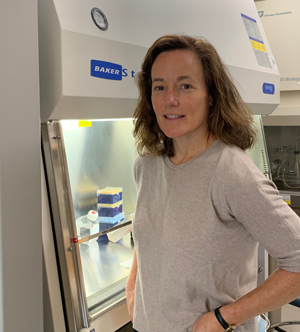
|
A UMass Medical School research team has been awarded a National Cancer Institute grant to advance understanding of how hereditary breast and ovarian cancer genes work, and why tumors lacking these genes are sensitive to chemotherapy. Their findings challenge decades of research in the field that suggested chemotherapy was effective because it breaks tumor DNA into pieces.
New UMMS research suggests that chemotherapy works instead by poking holes in tumor DNA, killing tumors that already have fragile DNA, such as those that evolve from mutations in tumor-suppressing BRCA1 or BRCA2 genes, which are a major cause of hereditary breast and ovarian cancer.
Thus, a key indicator that a tumor will respond to chemotherapy, according to Sharon B. Cantor, PhD, is the presence of these holes or gaps in its DNA.
Dr. Cantor, associate professor of molecular, cell & cancer biology, is the principal investigator on the new, five-year $2.6 million NCI grant.
“These findings matter because the field’s current thinking is based on the idea that chemotherapy works by breaking DNA, and when tumors can’t fix broken DNA, the cancer cells will die,” Cantor said. “Now that people can study what happens to the DNA, this basic mechanism is in question.”
Researchers have understood for 30 years that BRCA genes make proteins that normally fix broken DNA and help maintain its quality. According to Cantor’s new model, BRCA genes also normally prevent small gaps from forming in DNA during replication. In cancers that are deficient in the BRCA genes, there is a defect in the ability to prevent these gaps. Chemotherapy exploits that vulnerability.
“Our data indicate that chemotherapy works because it generates holes or gaps in DNA that are already present in cells lacking the hereditary breast and ovarian cancer genes,” she said. “So the absence of the BRCA protein in your tumor, combined with chemotherapy, which is making more of these gaps, is what kills the tumor cells.”
The gap model of therapy response provides insight into to why, unexpectedly, chemotherapies often work even when DNA repair is intact or do not work even when DNA repair is defective, according to Cantor. Gaps are the key sensitizing factor.
Correspondingly, gaps are suppressed—strengthening the cancer cell’s DNA—when chemoresistance develops. And if helper drugs can be identified that re-establish gaps and weaken the DNA, it may be possible to resensitize these cancers to chemotherapy.
Cantor’s team recently published in Science Advances a discovery that some tumors turn on a pathway that suppresses gaps. The article is summarized in Science in Boston. The tumors may use a mechanism to replicate continuously, preventing their DNA from having gaps. As a result, the cancer cells avoid dying from chemotherapy.
The new grant will support the work of Cantor’s lab to map the region of the BRCA proteins that perform the gap-preventing function and determine if it is distinct from BRCA protein functions in repairing broken DNA.
Researchers will also look at whether BRCA-mutant patient tumors that are highly sensitive to therapy are making gaps, and if they become resistant to therapy, whether they are avoiding the gap.
Patient tumor samples will be analyzed with project collaborator Neil Johnson, PhD, at Fox Chase Cancer Center in Philadelphia, Cantor said. Nicholas Panzarino, a graduate student in the Cantor lab, will test the predictive value of the model, using robust tumor sequencing data correlated with patient response and looking at whether biomarkers that foretell whether a tumor responds to chemotherapy are consistent with the gap model.
The project’s findings could play a significant role in use of a drug called a “PARP inhibitor,” currently used in ovarian tumors but which is proposed for many other cancers, Cantor said.
“People are following the logic that a PARP inhibitor is going to work when you can’t fix broken DNA. Our data say that supposition is incorrect,” she said.
“They work because PARP inhibitors make gaps in the DNA and that cancers that already have fragile DNA are going to be sensitive. The thinking is really different. It would expand the use of PARP inhibitors in a logical, hopefully correct way, rather than shooting in the dark.”